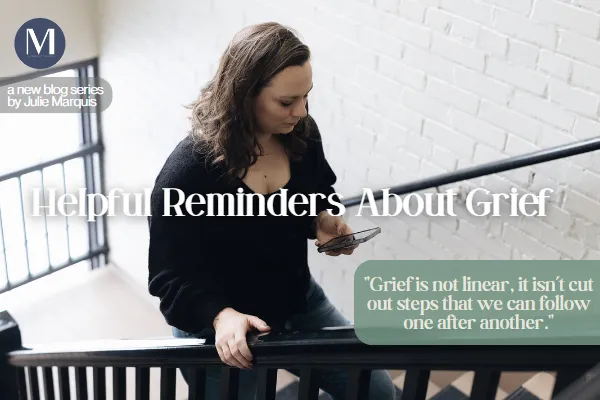the blog
A place for our team to share about topics they are passionate about, in hopes of allowing you to see and understand a bit more behind the faces on these pages.

Helpful Reminders About Grief
Grief is one of those complex and powerful things that can feel welcoming for some and terrifying for others. It’s a loaded term that encapsulates so many things because it combines our emotions, beliefs, experiences, hopes and dreams.
We’ve all experienced grief in one way or another. Whether it’s losing a friend, partner, parent, child, coworker, a job, a dream, a hope, or something else - all of these things can cause us to feel grief.
We often have this idea of what grief looks like, or what it “should” look like, and more often than not, it’s simply not accurate.
Grief is not linear. It isn’t cut out steps that we can follow one after another. Grief is something that can take us on a ride where we don’t know what’s around the next corner, and each turn feels more tight than the last.
It’s also important to remember that each one of us will experience grief differently, as we are all unique with unique experiences throughout our lives.
For some it can look like really big emotions, debilitating feelings, and not being able to get out of bed or function on a daily basis. Some may try to fight it, run from it, numb it out by throwing themselves into family, work, friends, addictions and the list goes on. It can feel like we’re just about to fall out of the car because it’s going so fast. We can feel overwhelmed and sad, angry and confused, exhausted and depleted. For others, it may be this deep, quiet, pervasive feeling that is just there regardless of whether we go to work, school, or stay in bed. There are no big outward expressions of feelings, but the depth of the grief is beyond what someone would ever see or know. Grief can also look like a combination of those things, something in the middle, or something completely different. It ultimately comes down to the individual.
There is a reason why historically people were encouraged to take a year for mourning and grieving. This allowed for the time and space to move through the shock of the experience (usually losing someone) and into a place where they could find some level of acceptance. Today in our society, many will only have maybe 3 days of bereavement leave - if that!! - and then there is this idea or expectation that we’re “back to normal” and “good to go”. It’s ridiculous. Grief and loss do not work that way.
One of the most powerful things we can do to help us grieve well is to give ourselves a lot of permission to feel the things we feel. More than you may be typically used to.
Don’t fight it, stuff it, or avoid it.
Welcome it. Enter into it.
Let yourself feel it and travel through it.
Eventually, through this process we will learn to cope with it on a daily basis and at some point it’s not the first thing that we think about in the morning. It isn’t something that is ever dealt with, and it doesn’t ever become finished. It’s something that we journey with and find some acceptance that some days it’s bigger and some days it’s smaller.
So, take this as your: take a breath moment - if you’ve lost something or someone and you’re in the midst of the grief, it’s ok that it’s taking time.
Til next time,
Julie
Office Location: 1200 Brock Street South, Whitby, ON. L1N 4L9
© Marquis Counselling & Consulting | ALL RIGHTS RESERVED | TERMS & CONDITIONS | PRIVACY POLICY
